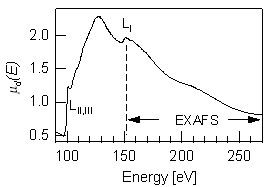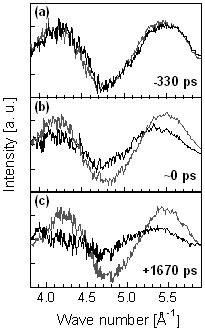Optical Science Laboratory
Å@The recent development of various ultrashort x-ray-pulse
sources based on high-power femtosecond lasers has stimulated progress on
ultrafast time-resolved x-ray probing techniques with femtosecond or picosecond
resolution. In particular, the time-resolved extended x-ray absorption fine
structure (EXAFS) approach is expected to become a powerful technique for
probing ultrafast structural dynamics, because EXAFS provides such structural
properties as bond distance and coordination number for various materials
including amorphous materials and liquids [1]. Here, we present a time-resolved
EXAFS technique with picosecond resolution that employs a soft x-ray pulse
emitted from femtosecond laser-produced plasma. By employing this technique,
we successfully observed the time evolution of an ultrafast melted Si L-edge
EXAFS induced by femtosecond laser irradiation [2].
Å@We constructed an experimental laser-pump and x-ray probe setup based on
a 100-fs Ti:sapphire laser system. Figure 1 shows an example of the absorption
spectrum of Si foil. We clearly observed the LII,III edge at 99
eV, the LI edge at 150 eV, and the damped oscillation, which corresponds to
EXAFS, in the region of 150 - 270 eV. Figure 2 shows the time evolution of
the EXAFS spectrum at various time delays, which was extracted from each absorption
spectrum. We can clearly see that the oscillation amplitude decreases with
a small peak shift to a lower wave number at a time delay of 0 ps while there
is no great difference between the EXAFS spectra of the pumped and unpumped
samples at a time delay of -330 ps. The small peak shift indicates that the
oscillation period becomes shorter than that of the unpumped Si and this strongly
suggests that the Si-Si atomic distance was broadened slightly by the laser
excitation. We obtained a Si-Si atomic distance of 2.43 Å, which is clearly
larger than the value of 2.32 Å for solid Si obtained by Fourier transformation
of the data. This expansion of the atomic distance can be explained in terms
of the ultrafast production of liquid Si. At a time delay of +1670 ps, the
EXAFS becomes too weak for us to analyze its oscillation structure. The disappearance
of the oscillation indicates the further structural disordering of Si due
to the onset of evaporation from the liquid phase to the gas-like phase. This
result is the first step towards establishing ultrafast time-resolved EXAFS
technique.
[1] T. Lee et al., Chem. Phys. 299 (2004) 233.
[2] K. Oguri et al., Appl. Phys. Lett.87(2005)011503
 |
 |
|
| Fig. 1. Example of Si-absorption spectrum. | Fig. 2. Transient EXAFS spectra with (thin black line) and without (thick gray line) laser irradiation. |